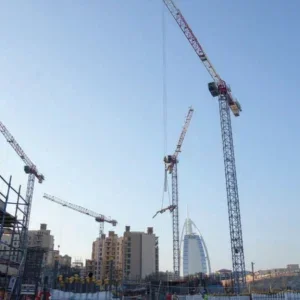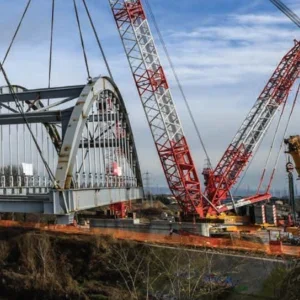Even so, the Australian economy enters 2008 with a significant tailwind. Australia’s trend growth will remain among the strongest in the Organisation for Economic Co-operation and Development (OECD). GDP per capita in Australia has surpassed most of the G7 with the exception of the United States. Although growth is set to trend down modestly over the medium term to the 2.5-3.0% range, long-term growth potential remains among the strongest of the OECD countries. The outlook is underpinned by Australia’s extensive endowment of mineral resources that include substantial, untapped reserves of natural gas and the dynamism of the domestic market, which following sweeping deregulation is one of the most open in the world. The economy’s high investment needs will be met by foreign capital inflows, drawn by the potential of the primary sector, the economy’s strong fundamentals and the strength of growth.
Spending in the construction sector will grow at a compound annual growth rate (CAGR) of 5.3%, from US$71.5bn in 2006 to US$120.3bn in 2016. Steady population growth, improving income levels, demand for commercial and industrial buildings, and huge investments in infrastructure will drive growth.
Spending on residential construction will grow at a CAGR of 4.9%, from US$26.2bn in 2006 to US$42.2bn in 2016. Steady population growth with strong net immigration, low unemployment levels, and wage growth will drive growth in residential construction. While high interest rates and low housing affordability from high land prices and regulatory costs will moderate growth, demand fundamentals will be able to overcome these factors.
An increase in the rate of urbanisation from 92.6% in 2006 to 94.0% in 2016, a 1.0% CAGR increase in population from 20.4m in 2006 to 22.5m in 2016, and a 2.1% CAGR increase in real per-capita income from US$22,900 in 2006 to US$28,300 in 2016 will drive growth in residential construction.
Renovation of residential units will drive spending on residential construction as well. Spending on large renovations and alterations is expected to grow by 4.5% annually, from 2004-12, to reach US$6.0bn (A$7.98bn) by 2011-12.
Spending on non-residential construction will grow at a CAGR of 5.6%, from US$45.3bn in 2006 to US$78.0bn in 2016. Growing spending on office space, healthcare facilities, and industrial buildings, along with investments in the transport, energy, and telecommunications sectors, will drive growth in non-residential construction.
In 2007, 14% of the Australian population was 65 years and older. This age group will increase to 26-28% of the overall population by 2051, leading to more demand for medical and healthcare services over the next 50 years. Such projects as Queensland Health Sunshine Coast Tertiary Hospital, Royal Children’s Hospital, Fiona Stanley Hospital/Health Campus – Southern Tertiary, Box Hill Hospital, and Royal North Shore Hospital (RNSH) will drive growth in non-residential structures.
Growth in office space construction spending due to high demand and leasing norms favourable to developers will boost growth in the non-residential structure sector. Average office space construction should be 651,400 square meters per year until 2011. A number of projects, such as Harbor Foreshore Park & Commercial Complex, Anza Headquarters Docklands Victoria Harbor, Queen’s Plaza Tower, and Sydney Olympic Park Commercial Precinct will drive office construction growth.
Construction spending in industrial buildings will grow at a CAGR of 6.0%, from US$4.7bn in 2006 to US$8.5bn in 2016. Investments will be made in such projects as the Hunter Economic Zone Industrial Estate, Swanbank Paper Production Plant, Macarthur-Stanwell Coke Plant, Dalrymple Bay Coal Terminal expansion, and Penola Pulp Mill, fuelling growth in non-residential structures
Spending on non-residential infrastructure will grow at a CAGR of 5.5%, from US$29.3bn in 2006 to US$50.0bn in 2016, driven by increasing foreign and domestic investment in infrastructure and federal government reforms. Investments in infrastructure development and maintenance are expected to be worth US$232bn in the next 10-20 years.
Construction spending in the transportation sector will grow at a CAGR of 3.5%, from US$12.3bn in 2006 to US$17.4bn in 2016. Growth will be driven by such projects as the Australian Inland Rail Expressway, Bells Line of Road Upgrade, Sydney to Brisbane Motorway, Goodna Bypass, M4 East Expressway Extension, and Wiggins Island Coal Terminal Project.
Gross electricity output in the country will increase at a rate of 2% per year to 342 terawatt-hours (TWh) during 2019-20, and natural gas production will more than double from 1,685 petajoules (PJ) in 2004-05 to 4,480 PJ in 2019-20. As a result, construction spending in the energy sector will increase at a CAGR of 9.1%, from US$9.2bn in 2006 to US$21.9bn in 2016. Projects such as the Darwin LNG Plant Expansion, Ichthys Gas Project, and Cape Preston Iron Ore Project will drive the growth.
While growth slows across the board for non-residential structures, the shift in growth leadership moves from office and commercial to commercial and industrial as Australia moves to provide more of the capital that the developing countries of the region require. Within the infrastructure category, the energy sector remains by far the growth leader, with only minor slowing as economic growth continues and boosts energy consumption. Growth slows significantly in the transportation and water and sewer segments, as new residential construction moderates under affordability concerns. The types of structures, particularly within the energy sector, that are likely to be built over the next several years will be conducive to crane use.
The main challenge facing Australia over the medium-term is that of raising productivity to offset the negative impact of population ageing. Productivity growth has moderated after surging following the implementation of reforms under the National Competition Policy (NCP). Key issues include continued improvement in market competition, particularly in the provision of infrastructure services, the lack of which has acted as a constraint on growth. In particular, water resource management is an increasingly pressing issue amid climate change.
While the labour market is flexible relative to OECD peers, participation rates could be further raised by measures to increase female participation rates and reduce structural unemployment. Education policies also require adjustment to boost levels of secondary and tertiary education, which remain low relative to OECD peers, to support the development of service and knowledge industries. Finally, Australia’s active pursuit of bilateral trade agreements and involvement in global trade rounds will serve to lower tariff barriers, boost integration into production chains and increase domestic competitiveness.
Household spending
Although private domestic-demand growth should eventually moderate as interest rates remain high, stimulants to growth remain strong. Households should be sensitised to interest-rate adjustments given record levels of private debt.
Yet, high employment, associated wage growth, and rising levels of net in-migration continue to fuel private consumption while multi-decade high terms of trade will support investment. Total population is growing at its fastest rate in two decades, expanding 1.5% last year to break the 21m threshold; net migration rose to a record 177,600 in 2007. Growth in the domestic population continues to support housing market activity with continued appreciation in house prices maintaining a positive wealth effect.
Finally, fiscal stimulus will come from the expansive budget adopted by the government for the current fiscal year, which will pump around US$55bn back into the economy in the form of tax cuts and welfare spending.
Domestic demand growth should begin to temper in the second half of the year under the influence of high interest rates. Exports should maintain traction, although the drought in rural areas will hurt farm shipments. The Australian dollar’s strength will also have a dampening effect. Mineral and hydrocarbon exports should remain positive, supported by continued tightness in global commodity markets as Chinese and Indian growth remain robust and new capacity generated by heavy investment comes on-stream.
US subprime crisis related risks overshadow the outlook. The potential for domestic financial stress, such as is being experienced in the United States, is limited by tighter regulation of mortgage financing in Australia, which has resulted in a far lower proportion of subprime loans and arrears. A greater risk is posed by any slowdown in global growth due to a prolonged downturn in the United States. Commodity demand could slacken, hindering the rebalancing of growth sought by current policy. Given the balance of forces, Global Insight forecasts a modest deceleration in growth to 3.6% in 2008 and 3.1% in 2009.
Private consumption has proven the main driver of growth over the recent business cycle, buoyed by rapid appreciation in house prices, net in-migration, and rapid employment growth. Conversely, negative net exports have detracted from growth despite the recent surge in global commodity prices, which have boosted primary sectors. Imports have consistently outstripped export volumes which have been undermined by infrastructure bottlenecks and insufficient capacity. As firms have sought to redress these constraints, private capital expenditure has recorded robust growth, while higher rates of public spending are supported by the strong fiscal balance. The labour market has tightened, with unemployment falling close to 30- year lows.
In annual terms, gross fixed-capital formation soared 10.6% in 2007.
An acceleration in core inflation reflects domestic demand pressures. The economy is now in its 16th year of unbroken growth. Capacity utilisation rates remain high, with constraints emerging. New investment to increase production capacity and ameliorate infrastructure bottlenecks has been supported by strong earnings, particularly in mining.
Employment has expanded rapidly, with the unemployment rate now standing at near-33-year lows. As the labour market has tightened, wages have accelerated, with growth concentrated at the higher-skilled end. Household spending has been further stimulated by the positive wealth effect generated by rising house prices, which have encouraged equity withdrawal. In 2007, average house prices rose 12.3%, with high levels of in-migration further fanning demand. In some areas the rate of increase was close to 20.0%.
Rapid growth in consumer debt has been offset on household balance sheets by growth in asset values, but any sharp downturn in house prices could disrupt that equilibrium. Moreover, following recent volatility in financial markets, higher inter-bank and short-term rates have resulted in an increase in borrowing costs, constituting an effective tightening of monetary policy. The ramifications of any crisis for the wider economy could be more significant in Australia than elsewhere in the region given the higher recourse of companies to financial markets to fund investment and the highly leveraged state of households with debt offset against rising asset prices.






